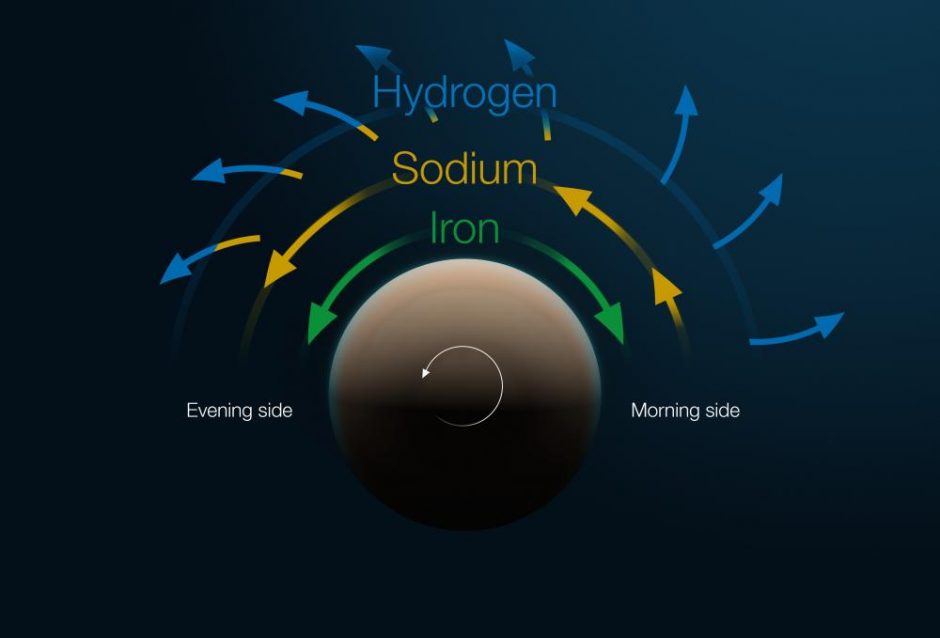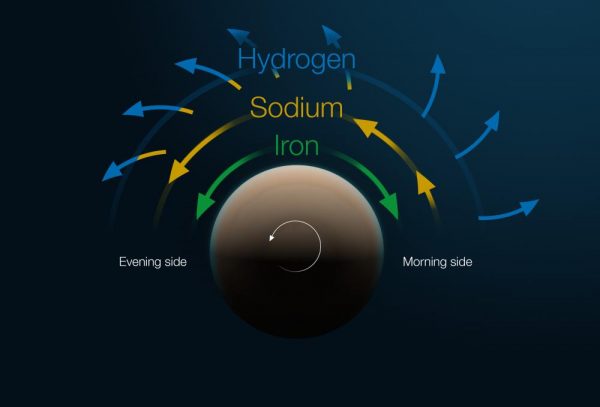This exoplanet’s extreme climate defies all models

WASP-121b is one of the most studied exoplanets. Known for its extreme conditions—such as clouds of metal vapor—it belongs to the category of ultra-hot Jupiters. To explore its mysteries, an international team of astronomers, including researchers from the University of Geneva’s (UNIGE) Department of Astronomy and the PlanetS National Research Center, combined observations from the four giant telescopes of the European Southern Observatory’s (ESO) Very Large Telescope. By probing multiple atmospheric layers, they have produced the most detailed dataset to date on an exoplanet’s atmosphere. Among their discoveries: the presence of powerful and completely unexpected winds. Published in Nature, these findings challenge existing atmospheric models.

Structure and motion of the atmosphere of the exoplanet Tylos (WASP-121b). The planet rotates counter-clockwise, in such a way that it always shows the same side to its parent star, so it’s always day on one half of the planet and night on the other. © ESO/M. Kornmesser
Ultra-hot Jupiters are exoplanets as massive as Jupiter (300 times the size of Earth), but which, unlike Jupiter, orbit very close to their star. This proximity and their large size make them easier to detect and study. However, their extraordinary insolation – thousands of times more powerful than Earth’s – generates a climate more extreme than that of any planet in the Solar System. This makes ultra-hot Jupiters ideal laboratories for testing theories and numerical models of planetary atmospheres and climates.
WASP-121b, also known as Tylos, is one of the most studied ultra-hot Jupiters. This gas-giant planet lies some 900 light-years from Earth, in the southern constellation of Puppis. It takes just 30 hours to circle its star and passes in front of it almost daily.
It was during this passage, or “transit”, that astronomers simultaneously pointed the four giant telescopes making up ESO’s Very Large Telescope (VLT), located on Mount Paranal in the Chilean Atacama Desert. The starlight, filtered through the atmosphere of the transiting exoplanet, was then collected by each of the four eight-meter-diameter mirrors and channeled via optical fibers to the ESPRESSO instrument, built and installed in 2018 under the responsibility of UNIGE’s Department of Astronomy.
“ESPRESSO is a spectrograph, i.e. a rainbow machine that breaks down starlight into colors. The more light we have, the brighter the colors and the more precise the observations. By combining four such large telescopes, ESPRESSO collects more light than any other spectrograph in the world,” explains David Ehrenreich, associate professor in the Department of Astronomy at the UNIGE Faculty of Science and co-author of the study. “We can thus achieve a level of detail never before obtained in our observations of this exoplanet’s atmosphere”.
Theory shaken up
The team was able to probe several layers of WASP-121b’s atmosphere. By detecting and tracing the path of iron, sodium and hydrogen vapors at different altitudes, they determined the speed of winds blowing at low, medium and high altitudes. The result, a three-dimensional map of atmospheric circulation, overturns theoretical predictions: “This planet’s atmosphere behaves in ways that challenge our understanding of how weather works, not just on Earth, but on all planets. It’s like being in a science-fiction movie”, says Julia Victoria Seidel, a former doctoral student at UNIGE, now a researcher at ESO and the Lagrange laboratory in France, who led the research team.
Strong winds
A powerful updraft lifts the heavy iron vapors from the scorching depths of the day side and expels them towards the much cooler night side. This updraft is overhung by a fast air current, or jet stream, which circulates air from the intermediate layers around the planet’s equator. “Theoretical models predicted exactly the opposite, reversing the position of these two layers!” exclaims Julia Seidel.
This surprising atmospheric circulation pattern is completed by the expansion of the highest atmospheric layers, dragged along and stirred at their base by the jet stream. The lighter gases, such as hydrogen, eventually escape the planet’s gravity. “Even the Neptunian winds, the most violent in the Solar System, blowing at 2,000 km/h, seem like a gentle breeze compared with the fury of WASP-121b’s winds, which reach 70,000 km/h”, adds Julia Seidel.
From extreme to temperate climates
If the weather conditions prevailing on Tylos are challenging the general circulation models used to simulate planetary climates, it’s precisely because ultra-hot Jupiters are pushing these models to their limits, even beyond their field of application. This is precisely what scientists are interested in: understanding and simulating the most extreme climates to make them compatible with these observations. This will probably require taking new physical phenomena into account.
Studying the climates of potentially habitable exoplanets, however, will require even greater resources. ESO’s Extremely Large Telescope (ELT), currently under construction on Mount Armazones in Chile, should provide the first answers around 2030. “With the ELT and its 39-meter-diameter mirror, we’ll be entering a new era,” says David Ehrenreich. UNIGE is one of the prime contractors for ANDES (ArmazoNes high Dispersion Echelle Spectrograph), the VLT equivalent of ESPRESSO. “ANDES will allow us to study Earth-like climates, and we’re sure to be in for some surprises!’’.
Publication : DOI: 10.1051/0004-6361/202452405
Categories: News
